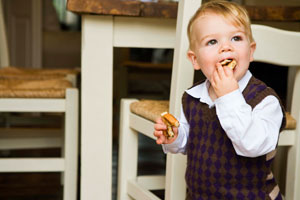If you are raising a toddler, then you need very few reminders of how it can be a real struggle to get your little one to eat a nutritious and balanced meal. Nutrition expert Christina Schmidt has spent some time in the trenches giving parents the guidance they need to turn their kitchens into mêlée-free toddler bistros.
Create a toddler-friendly eating area for your child. Toddlers like their own spaces and may eat more of your lovingly prepared meals at a table sized just for them. Also, be sure to accommodate with plates, cups, forks, and spoons that are just for your kid. Be creative by using colorful place mats and matching dishes decorated with your child’s favorite cartoon characters, cars, trucks, princesses, animals, etc.
Outsmart that little rebel. If your child likes to test his limits by saying “no” a lot when it comes to the foods that you offer, be sure to turn away from his tantrums. Giving attention to his protests often fuels the fire. Instead, offer him just a few choices. By giving your child a choice or two at mealtimes, you’re letting him feel that he is still part of the decision-making process and that he has some control.
Invite your grazer to the table ... but still give him room to roam. Focusing on food is sometimes an insurmountable task for toddlers. They may be grazers who rarely sit and finish a meal and would rather snack throughout the day. Don’t worry—if you make progress with one out of three meals and some snacks, you are doing very well. Keep up a consistent mealtime and snack routine despite your little one’s obliviousness to the plate.
Expect the unexpected! Toddlers can be highly unpredictable. One day it’s “I don’t want it!” and the next week the same kid can’t get enough of the once-hated food, or vice versa. Whatever it is, as long as you keep offering healthy options to your toddlers, it’s a win/win situation.
Commit to being copied! Now is the time when you can make the biggest difference in your toddler’s eating behavior. Studies show that food preferences are shaped between ages two and three. Be a role model for healthy eating and manners in front of your toddler. Even if the results are not immediate, it will pay off in the long run!
Remember the three bears! Food should be presented to your toddler not too hot, not too cold, but just right, which is warm or close to room temperature.
Make each bite count. Pack each bite with nutrition because you never know when pickiness or loss of appetite will rear their ugly heads, sabotaging your efforts for the day. Your goal is to maximize the opportunity for your toddler to eat healthy, so make sure all of the foods that your toddler is eating are full of the vitamins and nutrients that he or she needs.
Keep the pressure in check. Don’t overreact, scold, bribe, beg, or reward with a treat to get your toddler to eat. Over-controlling your toddler’s eating behavior turns down the volume of the natural internal cues for hunger and fullness. Studies show that unpressured children will instinctively balance their diets.
An alternative to the “clean your plate” concept. Your job is to choose the menu and dining times for your child. Your toddler may decide which of your daily specials to eat, if any. If your child isn’t wolfing down everything on the plate, avoid requiring that your child clean it. Instead, try requesting “courtesy bites.” You may get your child to take a few bites of those peas without all the drama and stress that goes along with cleaning the plate.
Don’t replace food with fluids. Prevent your toddler from filling up on excessive fluids before meals. Offering sips of water or milk to quench thirst is fine. Two full sippy cups before a meal, however, may be the reason the plate goes back to the kitchen untouched.
Avoid short-order chef syndrome. Allow your little purists their eccentricities, such as not wanting foods to touch each other, but don’t cater to special food requests at each meal. This will only reinforce finicky behavior. Offer limited choices (broccoli or carrots?), and serve one sure winner with each meal. Try this trick: Offer a tablespoon of the suspect food with an old reliable favorite when your toddler is hungriest. It works!
Think weekly! Obsessing over getting all of the food groups into your toddler just might drive you bonkers. Instead, think weekly. Toddlers’ diets magically tend to balance out nutritionally over a few days to a week, so don’t panic if you come across a day that isn’t quite as nutrition-packed as you would have liked for it to be.
Step away from the stereotypes. Avoid stereotyping your toddler as picky, and make a mental note not to be a role model for finicky eating in front of your child. Chances are, if you continue presenting those “problem foods” to your child, he or she will eventually come around and may even begin to enjoy them. If you are a picky eater, now might be a great time to start tasting those healthy foods with your child! A child who is cast as a hater of all that is green may begin believing it himself, and may never try that broccoli again.
Grandfather in new foods with the old standbys. Slowly introduce new foods, and don’t make a big deal out if it. Every few days to few weeks, introduce an unfamiliar food into a meal with an old reliable, and let your toddler get used to the look and taste of the new offering.
Tasting needs the test of time. Most parents only reintroduce a food three to five times, while studies show that it takes eight to 15 times for new foods to get a green light from toddlers. Don’t give up. Keep reintroducing the food every few days.
If you grow it, they will eat it...or if they simply see how it’s grown, they will eat it. Go to the local farm for a tour so that your tot can see where his or her favorite foods come from and how they grow. Toddlers love to eat foods that they have watched develop from seed to plate, so go ahead and plant that vegetable garden!
Cultivate a culinary kid. Bring your toddler into the kitchen with you and let him or her help prepare foods. Toddlers love to help out and to create, and therefore might be inclined to eat what they’ve helped prepare. You can enlist your toddler, starting at around two years of age, to wash produce, peel bananas, stir and mix, sprinkle spices, help measure and pour ingredients, tell you when the timer goes off, hand you ingredients, decorate and arrange dishes, and help clean up. You can even try creating the menu together!
Become a food artist. Remember that you eat with your eyes before you eat with your mouth, so design and use colorful foods on the plate. Arrange green beans into a pine tree or a spider. Make a fruit or veggie rainbow on the plate.
Name it something new! Broccoli can be trees, peas can be baseballs, oatmeal raisin can be ant cereal, spaghetti and cheese can be slimy worms, tomato slices can be hot rod wheels. If your child loves fries or cookies, try cutting veggies and other less-favored foods into those shapes and call them “veggie fries” or “carrot cookies.”
Shape and sculpt. Cut foods into fun shapes. Use fun cookie cutter shapes for sandwiches, cheeses, and fruits. Make teddy bear-shaped pancakes and swirl mashed sweet potatoes with yogurt. Buy fun pasta shapes such as stars, suns, moons, animals, etc. Make foods as mini versions; silver dollar-sized pancakes, mini muffins, and tiny pizzas really do appeal to those little hands!
Tell a tale. Make a story out of your child’s meal. “Once upon a time, a bird dropped a very tiny seed...” In this way, your toddler’s bite of food becomes an important chapter in the story.
Set a serene table. Create a calm and relaxed dining atmosphere for your toddler. Stress can promote poor appetites, so put off your Table Manners 101 lecture for later and just enjoy your toddler time!
Make it a family affair. Bring the family together for meals as often as possible. Today’s world of working parents makes it tough, but it’s worth it to fit in at least one family meal a week; once a day is even better! Eating together at home provides a sense of structure and security for your toddler. Research shows that eating together leads to a healthier diet with less fat, trans fat, cholesterol, salt, and soda, and with more minerals, vitamins, and fiber.
Hide it! Sneak in a serving of veggies by hiding purées in mashes, sandwiches, pita pockets, sauces, or soups. Cover vegetables with sauces or grated cheese, or flavor them with dill, lemon, honey, olive oil, orange zest, or basil. Grate veggies into muffins, pancakes, breads, meatloaves, or salads.
Offer toddler-sized servings. Serve one tablespoon of each dish per year of age, or about one quarter of an adult serving at meals and snacks. Toddler stomachs are the size of their fists, so a little goes a long way. If you are in doubt, serve less than what you expect. In one study, three- to five-year-olds who were fed double portion sizes ate 15 to 25 percent more calories than those served proper portions.
Limit desserts and sweets. Toddlers will get sugar one way or another, so your job is to moderate how much and how often. Research has shown that early introduction to sugary foods encourages sugar cravings in adulthood.
Fruit juice flunks out of the toddler bistro diet. You may think that fruit juice is a healthy option for your child—and it is compared to soda and sugary drinks—but note that fruit juice still has a high sugar content, and it lacks protein. Milk and water are bistro favorites.
Soda pop not! Toddlers should be drinking milk and water. Soda contains empty calories, meaning that its calories are missing vitamins, minerals, and fiber. Soda displaces better beverages like milk from toddler diets and can compromise the immune system, dehydrate, interfere with nutrient absorption, and contribute to obesity.
Water wise. Train your toddler early on to select water from the menu. This refreshment is popular when served in fun cups, and it can be flavored with slices of orange or other fresh fruits. Have refills available in hot weather and during highly active times. Watch for signs of dehydration: dark urine in small amounts, thirst, flushed appearance, headache, fever, tiredness, dry mouth, or fast breathing.
Skip the salt. We get plenty naturally. Use half the salt called for in recipes and choose low-salt brand foods. Oh, and keep that shaker off the table!
Power struggles with food are dead ends. Believe it or not, diet improves with less parental control and more of simply providing a variety of healthy food choices. Trust your toddlers when they act or say that they are full. “Full” signs are turning the head away, throwing or playing with food, eating more slowly, trying to ditch the high chair, feeding the begging dog, and simply not finishing. Focus on offering many types of nutritious foods many times.
Be aware of the eight most typical allergenic foods. The “Bistro Big Eight” include eggs, milk, tree nuts, peanuts, soy, fish, shellfish, and wheat. Be aware of how your toddler may present signs of an allergy. If you suspect a food allergy, eliminate the questionable food(s) and contact your health care provider. Your child may need to be tested for allergies.
Choking checks. Avoid nuts, seeds, popcorn, chips, pretzels, vegetable and fruit skins, whole raw apples and carrots, whole green beans, small dried fruits, whole grapes and cherries, whole olives, berries, melon balls, tough or big pieces of meat, hot dogs, hard cookies and biscuits, globs of peanut butter and nut butters, pickles, and big bites! Toddler diners should be seated when eating and should not giggle or talk while chewing. Cook fruits and veggies according to how many teeth your toddler has, and supervise your toddler while dining.
Avoid trans fats. Breastfeeding moms, all toddlers, and everyone else should completely avoid or at least minimize eating this type of fat. Partially hydrogenated trans fats are commercially altered fats that make oils more stable and increase food’s shelf life. They are used in foods such as bakery goods, breads, snacks, and margarines. They contribute to the risk for diabetes and heart disease and interfere with growth and development. Read the labels and stay away from foods with “partially hydrogenated oil” or “trans fats” in the contents.
Low-fat and fat-free products aren’t always great for toddlers. Unless special circumstances exist, children under the age of two need full-fat foods and beverages to support healthy brain and body development. After two years of age, you may begin to substitute low-fat products for their full-fat counterparts.
Meats to miss. Avoid bacon, sausages, hot dogs, cured meats, and packaged deli meats. (Freshly sliced meats from the deli are okay.) Besides being high in fat and salty, they contain sodium nitrite, a preservative that can be cancer-causing when these meats are cooked at high temperatures and when sodium nitrite reacts with chemicals in the stomach. Recent data shows that 27 percent of toddlers are eating hot dogs, bacon, and sausage—not a healthy diet!
Pesticide perils. Pesticides not only kill bugs; unfortunately, they may also block toddlers’ abilities to absorb nutrients from foods, which interferes with normal weight gain and brain development. Pesticides have also been shown to decrease the normal vitamin and mineral content of some fruits and vegetables. Be sure to wash and scrub all fruits and veggies using warm water and a little liquid dish soap. Don’t forget to wash produce with rinds, like cantaloupes and oranges, because your cutting knife transfers pesticides and bacteria into the fruit! Remove outer leaves and break apart broccoli and cauliflower before washing.
Whenever you can, opt for organic! Look for the USDA 100 Percent Certified Organic seal on foods. It means that no artificial ingredients or preservatives are present and that foods are grown without conventional pesticides, antibiotics, hormones, irradiation, or genetically modified foods. Organic foods have also been found to contain more nutrients than regular produce.
Plastics in the news. Toddlers are vulnerable to certain chemicals (dioxins and DEHA) found in some plastic wraps, which may disrupt their normal hormone, immune, cognitive, and growth development. These chemical plasticizers are absorbed from plastic wrap into fatty and acidic foods, especially in the presence of heat and light. Leave an inch or more space between food and plastic wrap when storing food in the refrigerator or heating in the microwave. Store leftovers in glass containers or baggies, repackage plastic-wrapped store-bought foods, and take out foods packaged in Styrofoam containers when you get home. And throw out those old plastic containers!
Bravo for breakfast! Studies show that toddlers who eat breakfast are better behaved, have increased attention spans, have better problem-solving skills, have boosted metabolisms, and have a lower risk for obesity than those who skip this meal.
The case for carbohydrates. Although carbohydrates are the diet buzzword of the twenty-first century, toddlers need them! Carbs are the brain’s first choice for fuel. They get a bad rap because of the “refining” process, how they are cooked, and the fact that they are often over-eaten. Go for 100 percent whole grains in breads, rice, pasta, and cereals. Carbohydrates are also in beans, fruits, and vegetables, especially the starchy veggies like corn, potatoes, and peas.
Protein. Toddlers need protein for growth, tissue repair, muscles, hair, skin, hormones, healthy bones, and healthy immune systems. Protein also helps fight plaque buildup on teeth! Foods with a protein punch include meats, fish and dairy products.
Calcium. Calcium is essential for strong bones and teeth! Only 50 percent of children ages one to five meet the recommended daily amount for calcium, and it ranks as one of the most common nutrient deficiencies. Not to worry: one cup of milk plus one-half cup of yogurt will satisfy your toddler’s daily calcium requirement.
A side of supplements. It’s easy to go overboard when considering the wide array of supplements available in today’s market. Toddlers should get the bulk of their nutrients from their actual food rather than from using nutritional supplements as an excuse to eat candy and french fries. While supplements can be helpful, just don’t use them as a substitute for a healthy, balanced diet.
Incorporating iron. Iron from meats, poultry, and fish is more easily absorbed by humans than iron from plant sources. Vitamin C foods and foods high in protein increase iron absorption. If you have a famous spaghetti sauce recipe, try cooking it in a cast-iron pot. This is another way to add iron to your veggie-based foods.
Keep a sharp eye on toddler tubbiness. (Baby fat is fine, obesity is not.) Some cultures believe that chubby children are healthier. On the contrary, clinically overweight toddlers are in greater danger of developing chronic diseases. They also battle peer ridicule and poor self-esteem.
Praise them! Reinforce healthy eating with praise and role modeling. You’ll be amazed how far this will take you.
Christina Schmidt, M.S., is a nutritionist and a certified nutrition educator who has been featured on NBC’s Today Show and has written nutrition articles for The Bump magazine. She is also the author of The Baby Bistro, The Baby Bistro Box, and The Toddler Bistro: Child-Approved Recipes and Expert Nutrition Advice for the Toddler Years (Bull Publishing Company, 2009).
Christina is President of Baby Bistro Brands and lives in Santa Barbara, California. For more information, please visit www.BabyBistroBrands.com.










